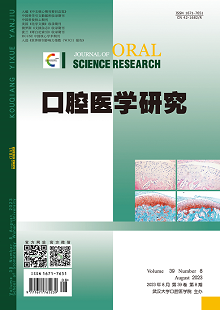|
|
Effect of High-fat Diet on Osteoarthritis of Temporomandibular Joint in Mice
ZHAO Chen, SHANG Qinglong, ZHAO Tiantian, ZHANG Bicheng, SU Tong, LIANG Beibei, LIU Boyu
2023, 39(8):
707-714.
DOI: 10.13701/j.cnki.kqyxyj.2023.08.009
Objective: To explore the effect of high-fat diet on temporomandibular joints osteoarthritis of the mouse by examining the expression of IL-1β, TNF-α, and VEGF. Methods: Forty-eight mice were randomly divided into regular diet(ND)group, abnormal occlusion with regular diet(MF+ND)group,abnormal occlusion with high fat(MF+HFD)group, and abnormal occlusion with mixed diet(MF+MD)group. The study used the unilateral anterior crossbite method to establish the mechanical force model. At the end of the 2nd, 4th, 6th, and 8th week after the model was established, the bilateral temporomandibular joints were collected. HE staining and saffron O staining of condylar cartilage were observed and scored pathologically. The expression of IL-1β, TNF-α, and VEGF of the condylar cartilage was detected by immunohistochemical staining. Results: In the MF+ND group, condylar cartilage destruction was visible and Mankin score increased, while MF+HFD group had more severe destruction and higher Mankin score. Immunohistochemical staining showed that the number of positive cells identified for IL-1β, TNF-α, and VEGF was significantly higher in each model group. Moreover, the expressions of IL-1β, TNF-α, and VEGF positive cells in the MF+ND, MF+HFD, and MF+MD groups were significantly different (P<0.05). Conclusion: High-fat diet can aggravate the condylar cartilage destruction in temporomandibular joints osteoarthritis in mice induced by occlusal abnormalities and aggravate the degree of temporomandibular joints osteoarthritis in the mice.
References |
Related Articles |
Metrics
|

